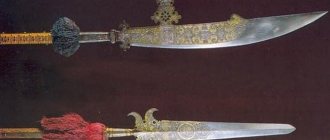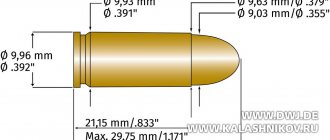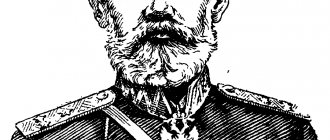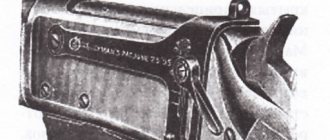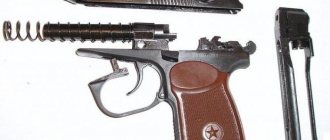From the series “Game Animals of Russia” Scientific hand. S. Cherenkov Adaptation and processing - Drozhdina Ekaterina. Especially for zatrofeem.ru - hunting tours in Russia.
| Comments: Message from: oleg 10/09/2011 22:02:18 |
| bear eats game from a snare, hopeless what to do |
More on the topic:
Rohatina, sulitsa and sovnya. Special varieties of Russian spears
Russian warriors of past centuries could use different weapons. However, for centuries the main weapon of infantry was the spear. Such weapons constantly evolved due to changes in certain design features, which allowed them to more fully meet current requirements. The evolution of the spear has led to the emergence of several special variants of particular interest.
Spearheads of the 11th-13th centuries. Photo Swordmaster.org
Classification issues
It is known that in the Middle Ages and later, the development of weapons in Rus' was a constant and continuous process.
New weapon designs appeared regularly, incl. polearms, which then became widespread and gave warriors advantages over their enemies. For obvious reasons, most of the copies and other weapons disappeared without a trace, but the surviving samples help archaeologists and historians restore the overall picture and its individual elements. The history of the spear in Rus' is constantly being updated with new details, but the general paths of its development have long been defined and well studied. There is also a classification of spear tips used in different periods.
For example, in the work of A.N. Kirpichnikov’s “Ancient Russian Weapons”, the known spearheads are divided into seven types with several subtypes. One type includes weapons with a similar design and outline, and the subtypes depend mainly on the size of the product. A division by period was also applied, which made it possible to classify finds from the 9th to the 13th centuries.
Different versions of the slingshot. Illustration from the book “Historical description of clothing and weapons of Russian troops”
Certain types of tips differ markedly from other representatives of the classification, which is why they can be of great interest. In addition, in the history of the Russian spear there are some controversial issues that should also be considered.
Weighting course
Perhaps the most famous type of spear in Rus' is the slingshot.
The first mentions in sources and archaeological finds of this kind date back to the middle of the 12th century. Subsequently, the slingshot became widespread in infantry and cavalry, and also became a hunting weapon. In the latter role, it continued to be used almost until the beginning of the last century. At its core, the spear was an enlarged, strengthened and weighted spear. It was made on the basis of a durable shaft of greater thickness and a length comparable to the height of a person. The feather of such a spear most often had a laurel leaf shape; the length of the tip could reach 500-600 mm. There were also special requirements for the strength of the bushing. The finished product was noticeably larger than other copies, and also several times heavier.
Due to the reinforced design, the spear could deliver more powerful piercing and slashing blows. Such weapons were distinguished by greater penetrating power, thanks to which they could be used both against infantry and in the fight against cavalry. The Russian army began to use spears almost immediately after their appearance - in the 12th century. The share of such weapons in the total number of copies was constantly changing, but was always quite large. The last mention of the use of slingshots in the army dates back to the 17th century. The further development of advanced weapons reduced the role of copies.
A textbook print depicting the hunting use of a spear. Wikimedia Commons
Special characteristics made it possible to use the spear for hunting. This “career” of the reinforced spear lasted much longer. Horns were used when hunting large and dangerous animals; the most famous use of such weapons was against bears. Some hunting spears were distinguished by the presence of a characteristic crossbar near the feather. This detail served as a kind of stopper and allowed the hunter to keep the struck prey at a safe distance.
Between spear and arrow
In the past, throwing darts were very common.
In Rus', such a weapon was called sulitsa. It was a throwing spear of small size and limited weight. In fact, it was larger than a bow arrow, but smaller than a normal spear. The first examples of this kind date back to the 9th century. Sulitsa were used by all Slavic tribes, and then entered service with armies and squads. The development of such weapons generally followed the evolution of spears, although with some differences. In appearance and design, the sulitsa was similar to a spear, but was smaller and lighter. The length of the shaft usually did not exceed 1.5 m, and the tip was no longer than 200 mm. To simplify the design and save money, the tip could be equipped not with a sleeve, but with a petiole driven into the shaft.
Both small and light and larger and heavier samples are known. The difference in mass led to some differences in combat qualities. Like spears, sulitsa received tips with feathers of different shapes. Basically, elongated types were used, capable of showing the best penetrating effect when thrown.
Modern reconstruction of the sulitsa tip. Photo Dic.academic.ru
The main way to use the sulitsa was to throw it at the enemy. Depending on the mass and speed, such a weapon could penetrate the enemy's light defense or, at a minimum, get stuck in it. An infantryman could carry several sulits and some other weapons, which expanded his combat capabilities. The use of the sulica as a spear was not excluded, but its effectiveness was limited by objective factors.
The period of relatively active use of throwing pole weapons occurred in the 10th-13th centuries. Subsequently, changes in battle tactics and the emergence of new types of weapons led to a reduction in the use of sulitsa. Later they fell out of use.
Mysterious owl
In 1841, the publication of a multi-volume work by A.V. began.
Viskovatov “Historical description of clothing and weapons of Russian troops.” This work collected all known data about the weapons of the Russian armies, but there was also some new information. One of the mentioned examples of polearms caused controversy. In the first part of the book, the owl was mentioned among the weapons of the infantry and cavalry. This weapon was defined as something like a spear with a tip in the form of a large knife with one-sided sharpening. The book also had two drawings - one depicted the iron owl itself, and the second showed a horseman with such a weapon.
The first known image of a spear of the "owl" type (below). Illustration from the book “Historical description of clothing and weapons of Russian troops”
It was later determined that the term “owl” had not previously been used in relation to any real weapon. There was something similar only in one of the lists of the First Novgorod Chronicle, but even in this case there was no complete certainty. The fact is that this fragment of the document is written illegibly, and in other lists other weapons appear in this context.
Over the past century and a half, the history of Russian polearms has been seriously expanded and comprehensively studied. Despite this, any traces of the owl described by A.V. Viskovatov, have not yet been discovered. However, the name “sovnya” or “owl” has come into circulation and is still quite actively used.
Different Russian museums store different archaeological finds, called owls. Moreover, to this day it is unclear what kind of real weapon the author of the “Historical Description” had in mind. The version about a mistake made is very popular. However, not all questions in the context of owls have answers yet, and the debate continues.
Specialized and durable
The development of copies in Rus' continued for several centuries and led to very interesting results. At different periods, based on the “ordinary” spear, various specialized samples with certain features appeared. However, one of the main weapons of infantry and cavalry was still the spear in its original form - with one type of tip or another.
Horsemen with polearms. The fighter on the left has an owl. Illustration from the book “Historical description of clothing and weapons of Russian troops”
The reasons for this are quite clear. Spears of the main types, despite the development and changes in design, were simple, convenient and versatile weapons for an infantryman or horseman. Other models, such as the Rotina or the Sulitsa, were intended to solve specific problems and therefore were only supposed to complement the main weapon. However, this role did not have a negative impact on their distribution. All known types of copies were actively used and refined.
Over time, polearms lost their value to armies. However, some of its varieties were still of interest to hunters. Of all the specialized varieties of spears, the spear remained in use the longest, the features of which were useful not only on the battlefield. But in the end, she was unable to compete with newer and more advanced weapons using different principles.
News
In Chukotka, polar bear hunting may resume in the coming winter. A seventeen-year-old American woman killed a bear with a bow. In Kuzbass, hunting huskies were tested... by a bear. Evenkia: game wardens catch a bear attacking people . Sakhalin region: a “hotline” will open for those who are going to go out to find a bear in the Russian Federation and USA: the annual quota for the production of polar bears has been approved by both sides Tyumen region: the hunting season for bear and wild boar has opened Chukotka: a white polar bear killed a 23-year-old boiler room worker Karachay-Cherkessia: over the past week, bears attacked a person twice with fatal results USA: prohibited import polar bear skins into the country Sakhalin region: 32 bears were killed during the last fall hunting period Memo about meeting a bear in the taiga Udmurtia: a hunter who caught two cubs for sale was fined Bashkiria: hunting for brown bears was banned Russia: Ministry of Natural Resources supported the initiative tighten the rules for transporting the skins of polar bears Bashkiria: a hunter fell into the clutches of a female bear he wounded Kamchatka: hunting for a brown bear is prohibited until August 19 Udmurtia: winter hunting for a brown bear and spring hunting for a wild goose is prohibited Udmurtia: illegal hunters are increasingly hunting bears Tomsk region : the governor proposed hunting bears all winter Kostroma region: for the first time it will be allowed to hunt bears in the spring Tomsk region: much more bears will be hunted Udmurtia: spring hunting of brown bears is allowed for the first time Sakhalin region: experts warn against eating meat from hunting trophies Tomsk region: quantity bears have reached a critical level for the region Sakhalin region: a hotline will open on questions of brown bear hunting Irkutsk region: a bear attacked a person Tyumen region: licenses for bear hunting were distributed using an online draw Sweden: hunters will be allowed to hunt every tenth bear Yakutia: a villager killed an attacking bear with a knife Krasnoyarsk Territory: Brown bear hunting is losing popularity Sakhalin: Hunters in 2014 are allowed to kill three hundred bears Sakhalin Region: The Ministry of Agriculture will set up a “hotline” for hunters Irkutsk Region: Brown bear hunting begins on April 1st Kemerovo Region: ban for brown bear hunting is canceled on April 20 Sakhalin: a hotline will open for questions about brown bear hunting Tyumen region: in ten years the number of bears has increased by 2.5 times Tatarstan: a hunter was bitten by a bear
